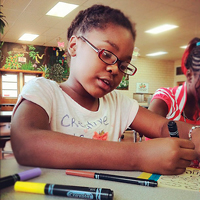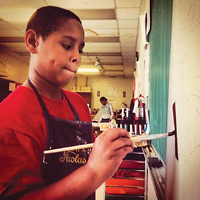
As soon as Todd Hale, a professional artist and ART 180 program assistant, started chatting with a shy seventh-grader named Stephon in the cafeteria of Binford Middle School in Richmond, he knew he’d met a fellow artist.
“I was immediately impressed with his mature perspective on the power of expression through making art,” says Hale.
Stephon has since used the after-school art programs offered by ART 180 to, as he describes it, “Create collages to express Myself as the person that I am today. I try to mirror my personality with different colors and actions. Every color is filled with different kinds of positive motivations, and that’s why I came to ART 180.”
Marlene Paul, executive director of ART 180, says the group’s mission is to guide Richmond-area young people from eight to eighteen who are living in challenging circumstances to use art to explore and express who they are. “Through these programs, the kids discover ways they can Positively engage in and influence their surrounding,” says Paul.
 Fourteen-year-old Jendayi describes ART 180 this way: “The program is unique. It dances to its own beat. It doesn’t do what everyone else is doing. There are different activities, different snacks,” she laughs. At school or on the school bus, she says, students often don’t talk to each other. But in the accepting environment of the ART 180 program, “the whole group was very ready to listen to others. It’s crazy how that was. I guess it’s because everyone has a story, and we got to hear it.”
Fourteen-year-old Jendayi describes ART 180 this way: “The program is unique. It dances to its own beat. It doesn’t do what everyone else is doing. There are different activities, different snacks,” she laughs. At school or on the school bus, she says, students often don’t talk to each other. But in the accepting environment of the ART 180 program, “the whole group was very ready to listen to others. It’s crazy how that was. I guess it’s because everyone has a story, and we got to hear it.”
One year ago, ART 180 opened its art center for teens, called Atlas, in Richmond’s arts and culture district in historic Jackson Ward. “At Atlas,” Jendayi says, “I felt like everyone was family. I could tell anybody anything. I could connect with anyone. At school, I have to be somebody else. Here I can be myself, so that’s good.”
For more than fifteen years now, ART 180 has successfully engaged professional artists and volunteers to work with youth after school in the community, and at Atlas. According to Betsy Kelly, program director, each program grows from the needs and interests of the group of young people being served. “The young artists are asked to explore crucial personal statements that reinforce their sense of identity and purpose,” says Kelly. “At ART 180, we have kids asking: What makes a hero? What do I stand for? How can I make my community a better place?”
 To build community, ART 180 programs culminate with a public presentation of artwork. These have included city billboards, art exhibits, and Cds. By merging the private creative experience with a public showcase, ART 180 offers youth a safe way to talk about what matters most to them, while offering the community a compelling way to hear it.
To build community, ART 180 programs culminate with a public presentation of artwork. These have included city billboards, art exhibits, and Cds. By merging the private creative experience with a public showcase, ART 180 offers youth a safe way to talk about what matters most to them, while offering the community a compelling way to hear it.
 ART 180’s fun is contagious, but also profound, as art helps those students who might not otherwise find a voice or an audience willing to listen. Former Poet Laureate, Rita Dove, explains why providing youth with this opportunity is so important: “If our children are unable to voice what they mean, no one will know how they feel. For a young person growing up in America’s alienated neighborhoods, there can be no greater empowerment than to dare to speak from the heart – and then to discover that one is not alone in one’s feelings.”
ART 180’s fun is contagious, but also profound, as art helps those students who might not otherwise find a voice or an audience willing to listen. Former Poet Laureate, Rita Dove, explains why providing youth with this opportunity is so important: “If our children are unable to voice what they mean, no one will know how they feel. For a young person growing up in America’s alienated neighborhoods, there can be no greater empowerment than to dare to speak from the heart – and then to discover that one is not alone in one’s feelings.”
Or as young artist Stephon puts it, “When I’m in ART 180, I do positive things and I focus on it to have success. I use my mistakes to my advantage to spread goodness and success. I turn negative things into positive reality.”





